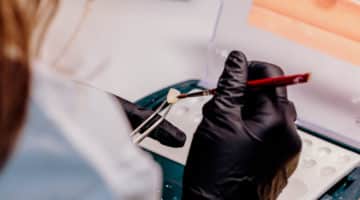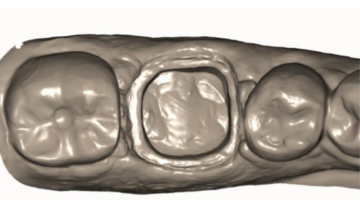Improvements in zirconia materials and the advancement of digital technology, scanners, and CAD/CAM systems make zirconia crowns easy to design, process, and fabricate. Understanding how to enhance zirconia crown cementation is essential to optimizing patient outcomes and maximizing the restoration’s longevity.
The popularity of zirconia crowns led to development of different types of the materials, including layered and monolithic zirconia, each of which have different clinical benefits. Also, zirconia provides a metal-free crown material alternative to porcelain fused to metal (PFM) materials.
The zirconia crown cementation technique differs from a PFM and other crown materials. Understanding these differences and mastering the zirconia cementation steps for zirconia crowns can help you deliver these restorations with maximum efficiency and improved patient outcomes.
Explore Dandy Zirconia Crowns
Dandy offers a variety of different dental zirconia crowns with various strengths, durability, and aesthetics.

Steps for zirconia crown cementation
There are a few steps for zirconia crown cementation. Many of these are similar to how you cement other types of crown materials. However, there are nuances that are particular for cementing zirconia crowns.
For example, zirconia adhesion benefits from surface abrasion. Therefore, the best cementation for zirconia crowns includes air abrasion of the zirconia surface with alumina particles. Zirconia adhesion is also enhanced by employing primers and cements that contain methacryloyloxydecyl dihydrogen phosphate (MDP).
Preparing the restoration
Zirconia restorations require preparation before you adhere them to the tooth. In particular, they need decontamination after the try in. Contamination will create a chemical reaction that interferes with adhesion.
So, before you attempt to place the restoration, you should remove anything that got on the restoration during the try in, like saliva. We recommend first sandblasting the intaglio surface of the restoration with aluminum oxide and then steam cleaning the restoration and allowing it to fully dry before attempting to affix it to the tooth. Other options for saliva decontamination can be airborne particle abrasion, zirconia cleaning solutions and hydrofluoric acid.
Pretreating the tooth
Once you have removed the temporary, it is essential to pretreat the tooth to remove all the residue from astringents, desensitizers, disinfectants, and temporary cement to provide the best possible conditions for adhesion. Mechanical cleaning with a pumice paste will work here.
Apply cement and seat the crown
Now you are ready to break out the cement. Studies show that the best cements for zirconia are those that contain MDP.
First, you want to get rid of the first bit of the cement to ensure there is a good mix for seating. Then dispense the cement into the prepared and decontaminated crown. Next, seat the crown using firm finger pressure.
Remove excess cement and clean up area
Once seated and after the tack cure, clean up any extra cement around the crown. Use your finger to continue to hold the crown in place when using the scaler.
It is essential only to give the cement the tack cure time indicated in the manufacturer’s instructions. Otherwise, it can take a lot longer to remove the excess cement.
Cure
Light cure the cement per the manufacturer’s instructions. Be sure to pay attention to the details regarding surfaces and distances involved with the curing light position. Once the cement has achieved the timing and curing required, finish and polish the restoration as desired.
What to avoid in zirconia crown cementation
As you cement the zirconia crown, here are things to not do:
- Do not use common surface treatments for zirconia crowns. Treatments like silanization and acid etching don’t work on zirconia’s inert surface.
- Avoid non-MDP cement formulations. Research also indicates that zinc-phosphate-and Bis-GMA-based cements and glass ionomer cements do not perform as well as those with MDP.
- Keep the phosphoric acid away from the zirconia during cementation. There should be no contact because the phosphate ion in the acid causes problems with zirconia’s potential adhesion.
- Avoid using prophy paste during cleaning to the prepared tooth. There are cleaning ingredients in the paste that contribute to crowns coming off.
- Do not use too much force during sandblasting during pretreatment. Experts recommend 30 t0 50 micrometers and a blast pressure of approximately 20-30 psi from two to three centimeters back for high strength zirconia and the lower end of those ranges for translucent ones.
- Do not rely on self-adhesives to retain the restoration in cases with limited mechanical retention. It may not be sufficient. Same goes for restorations that necessitate resin bonding. Studies show that a combination of micromechanical and chemical pretreatment is better for long-term bond performance.
- Stay away from luting cements with translucent zirconia. The opaque nature can interfere with the shade matching. Resin cements might be better here to enhance fracture resistance and optimize the strength of the restoration.
Can zirconia crowns be bonded?
Yes, you can bond a zirconia crown with a resin cement, but it is essential to use the correct protocol. Most bonding protocols are designed for bonding with glass, and zirconia is a ceramic. Therefore, bonding with zirconia requires different technique, one that creates a chemical and mechanical pretreatment.
When attempting to chemical bond with a silane coupling agent, ceramic primer, self-adhesive or adhesive cement, pretreat the zirconia crown to increase mechanical retention. You can achieve pretreatment with air-particle abrasion and tribochemical silica coating. The same goes when using a ceramic primer, self-adhesive or adhesive cement containing an acidic adhesive monomer, but with the caveat that you should follow up with a silane coupling agent to achieve chemical bonding with the surface now coated in silica.
Depending upon the zirconia you are using, a resin-modified glass ionomer (RMGI) cement works, too. For example, higher-strength zirconia formulations can bond using RMGI. However, zirconia that is optimized for aesthetics, like y5 zirconia, benefits from the strength of the resin cements.
Using zirconia-specific primers that can chemically bond to zirconia enhance the bond strength, too, particularly those that have 10-MDP in them. Primers that contain 10-MDP leverage phosphate-based bonding to chemically bond to zirconia.
However you decide to bond, please ensure that you follow the manufacturer’s instructions for the system you choose. These instructions ensure that you get the strong bond and the working time you need.
Zirconia Crowns with Dandy
Whether you’re new to zirconia crown cementation and assessing the advantages and disadvantages of zirconia crowns in your practice or have lots of experience with it, making Dandy your zirconia dental lab partner can help your practice and patient experience. Our clinical support team can help with material selection for your crown and bridge cases, case planning, digital dentistry, zirconia cementation steps, and more.
Ready to learn more about Dandy as your dental lab? Get in touch with us today!
Sources
Kongkiatkamon S, Rokaya D, Kengtanyakich S, Peampring C. Current classification of zirconia in dentistry: an updated review. PeerJ. 2023;11:e15669. Published 2023 Jul 14. doi:10.7717/peerj.15669
Sulaiman TA, Altak A, Abdulmajeed A, Rodgers B, Lawson N. Cleaning Zirconia Surface Prior To Bonding: A Comparative Study of Different Methods and Solutions. J Prosthodont. 2022;31(3):239-244. doi:10.1111/jopr.13389
Zirconia Crown Cementation. (2015) Available at: https://multimedia.3m.com/mws/media/1133847O/relyx-simple-steps-cement-guide-for-labs-no-logo.pdf (Accessed: 12 October 2023).
Gargari M, Gloria F, Napoli E, Pujia AM. Zirconia: cementation of prosthetic restorations. Literature review. Oral Implantol (Rome). 2010;3(4):25-29.
Cementing zirconia restorations. (2022). Available at: https://www.dentaleconomics.com/science-tech/article/16388075/cementing-zirconia-restorations (Accessed: 13 October 2023).
The Dos and Don’ts of Bonding Zirconia. (No date). Available at: https://www.bisco.com/assets/1/7/Dos_and_Donts_of_Bonding_Zirconia.pdf (Accessed: 13 October 2023).
Guide to Zirconia Bonding Essentials. Available at: https://kuraraydental.com/wp-content/uploads/2018/05/zirconia_bond_guide-1.pdf (Accessed: 13 October 2023).
Best practices for bonding with zirconia (no date) Dental Products Report. Available at: https://www.dentalproductsreport.com/view/best-practices-bonding-zirconia (Accessed: 13 October 2023).



